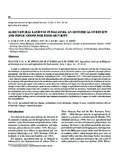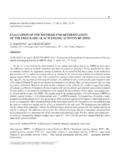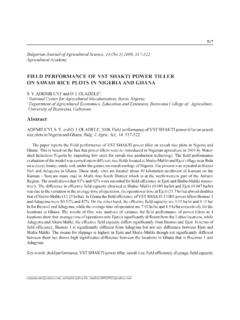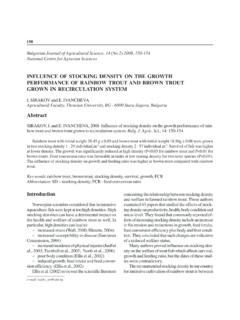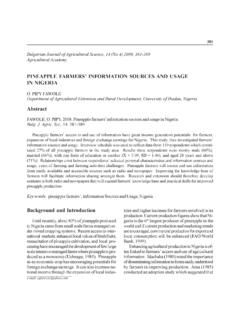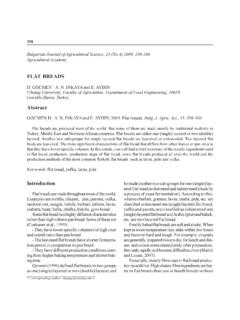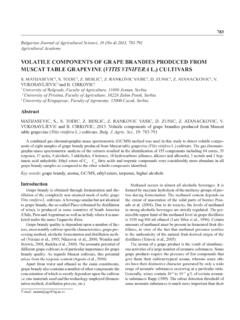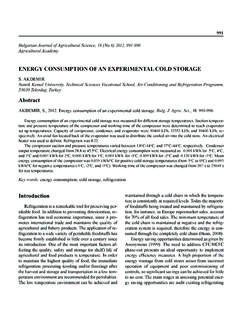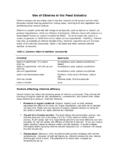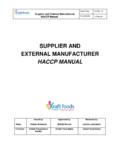Transcription of A MODEL HACCP PLAN FOR SMALL-SCALE …
1 501 Bulgarian Journal of Agricultural Science, 15 (No 6) 2009, 501-513 Agricultural AcademyA MODEL HACCP plan FOR SMALL-SCALE MANUFACTURINGOF tarhana (A TRADITIONAL TURKISH FERMENTED food )N. KARAGOZLU1, C. KARAGOZLU2 and B. ERGONUL31 Celal Bayar University, Engineering Faculty, food Engineering Department, Muradiye Campus, Muradiye, Manisa, Turkey2 Ege University, Faculty of Agriculture, Dairy Technology Department, Bornova, Izmir, Turkey3 Celal Bayar University, Engineering Faculty, food Engineering Department, Muradiye Campus, Muradiye, Manisa, TurkeyAbstractKARAGOZLU, N., C. KARAGOZLU and B. ERGONUL, 2009. A MODEL HACCP plan for small -scalemanufacturing of tarhana (a traditional Turkish fermented food ). Bulg. J. Agric. Sci., 15: 501-513 Most of the tarhana consumed in Turkey is homemade and therefore sun-dried.
2 However, there is a greatcommercial potential for the production of tarhana on an industrial scale using modern drying techniques. Sincetarhana produced by traditional methods is consumed widely and take an important role in diets of many people,safety of this product is so important in terms of consumer health. At this point of view, adopting a food safetysystem to tarhana production is so this study hazard analysis system was adopted to manufacturing line of tarhana , critical control points on theline were determined and a sample generic HACCP plan was recommended. Preventive and corrective actionsfor the critical steps were also discussed in the words: tarhana , HACCP system, food is one of the widely consumed traditionalfermented foods in Middle East countries and is ofgreat importance in the diet of Turkish people.
3 Tarhanais prepared by mixing yoghurt, wheat flour, yeast anda variety of cooked vegetables and spices (tomato,onion, salt, mint, paprika, tarhana herb, dill and basil)followed by fermentation for 1 7 days. Fermentationis usually carried out by yoghurt bacteria; Lactoba-cillus bulgaricus and Streptococcus fermentation the mixture is sun dried and groundto a particle size of nearly 1 mm (Ibanoglu et al., 1995).Instant tarhana is used to make tarhana soup by add-ing into water and boiling. tarhana has an acidic andsour taste with a strong yeasty flavor and is also agood source of proteins and vitamins and therefore isused widely for feeding children and elderly people inthe form of a thick soup (Turker and Elgun, 1995;Hammad and Fields, 1979) There are some otherproducts similar to tarhana such as kishk (Tamime etal.)
4 , 2000; Youssef, 1990), kushuk (Alnouri and502 Duitschaever, 1974), trahana (Economidou andSteinkraus, 1983) and tahonya/talkuna (Siyamoglu,1961). Methods for preparation of tarhana may varyfrom one place to another, but cereals and yoghurtare always the two major components. Since it hashigh nutritional properties, there is a growing com-mercial interest to produce tarhana soup in instant form(Ibanoglu and Ibanoglu, 1998).Most of the tarhana consumed in Turkey is home-made and therefore sun-dried. However, there is agreat commercial potential for the production oftarhana on an industrial scale using modern drying tech-niques (Maskan and Ibanoglu, 2002). tarhana is nothigh hygroscopic and it can be stored for 2 to 3 yearswithout any sign of it was believed that acidity and low wa-ter content prevent the growth and multiplication offoodborne pathogenic microorganisms.
5 But it wasshown by the researches that several pathogenic bac-teria can survive for over than 2 hours in foods havinga pH value of (Ghenghesh et al., 2005). Sincetarhana has a pH value of approximately (Ekinci,2005) and has a lot of ingredients in it, it can act like amedium for microorganisms. Not only microbiologi-cal risks, but also physical and chemical contamina-tions can occur during tarhana manufacturing becauseof the processing technique of the product. Especiallyphysical contaminations are seen during sun-drying oftraditional tarhana in SMALL-SCALE production most affective and well-known system forpathogen reduction and prevention of chemical andphysical contaminations and risks during manufactur-ing is HACCP is known as a combined system of mi-crobiology, quality control and risk assessment(Schmidt et al.)
6 , 2007). Through implementation ofHACCP system, hazards in any step of the manufac-turing chain can be identified and risks can be classi-fied. Other benefits of establishing HACCP system ina plant are reduced need for final inspection and analy-sis of a product, higher costumer satisfaction and trustin product safety, and improved food use of a highly structured Hazard AnalysisCritical Control Point ( HACCP ) system in food -safetycontrol is not new. The first food -industry HACCP application (in the 1960s) was by the Pillsbury had been contracted by National Aeronauticsand Space Administration (NASA) in conjunctionwith Army Natick Laboratories to design andproduce foods for space flights. The cooperativeHACCP program which evolved had the goal of nearly100% assurance that space foods produced wouldbe free of microbial or viral pathogens.
7 This system-atic, preventative approach combines the principlesof food microbiology, quality control, and risk assess-ment (Schmidt et al., 2007). HACCP is an effective system because of beingdesigned to provide the information flow for preven-tive and corrective actions and can easily be estab-lished on the production lines of all kinds of foods(Unnevehr and Jensen, 1998).The primary advantage of HACCP is that it is apreventative rather than a reactive approach tohazard identification and control in the food benefits to be realized include: moreefficient and directed use of resources, reduced needfor expensive end product testing, improved productquality, and higher customer can be adapted to plants that producedifferent kinds of foods, but industrial applications showdifferences because the flow diagrams of the prod-ucts differ.
8 Thus, all production lines have differentcritical control points (CCP) and HACCP plans (Topal,2001).A Critical Control Point (CCP) can be definedas any operation (practice, procedure, process, lo-cation, or step) at which there is a high- to medium-risk that lack of control will result in human risk; andat which control can be first step to establish the HACCP systemshould be to form the flow diagram of the productionline. In this way, critical control points can be deter-mined on the flow diagram sample and hazard analy-sis can be performed (Topal, 2001; Mortimore andWallace, 1994).Hazards seen in food manufacturing is divided into3 sub categories as follows,N. Karagozlu, C. Karagozlu and B. Ergonul503 Microbiological hazards are the potential forpathogenic organisms to survive, grow, contaminatethe product/raw materials and eventually cause food -borne hazards could result from a number ofsources: agricultural chemicals, insecticides, fungicides,etc.
9 ; cleaning/sanitizing agents and chemicals, certaintoxins, and misuse of food chemicals (preservatives,additives, etc.).Physical hazards include: inadvertent field mat-ter (stones, metal, insect fragments, etc.); inadvertentprocessing residues (glass, metal fragments, etc.); in-tentional materials (employee sabotage) and miscel-laneous particulates and fragments (Schmidt et al.,2008).In this study it was aimed to determine the pos-sible hazards and critical points in terms of food safetyon the production line of tarhana . Understanding thehazards involved and best practices for control areimportant in developing an improved food safety con-trol program for the tarhana and MethodsManufacturing of tarhana was realized by tradi-tional methods in tarhana Plant of Menemen Researchand Practice Farm of Agricultural Faculty, Ege Uni-versity.
10 First of all, identification of the product andthe target consumer profile were discussed and tradi-tional method of tarhana production was production consists in two stepped manu-facturing: tarhana dough fermentation and sun-dryingof the fermented tarhana dough. A sample flow dia-gram for tarhana production is given as Figure 1. Eachstep of tarhana manufacturing and possible risks andpreventive actions were explained in details conducting hazard analysis and using decision tree (Figure 2) critical steps of the process and critical limitsof these points were of the manufacturing flow diagramand critical control points were realized by HACCP team. HACCP team was consisting of 4 members ofthe staffs of Celal Bayar University Engineering Fac-ulty food Engineering Department and Ege Univer-sity Faculty of Agriculture Department of Dairy Tech-nology.
